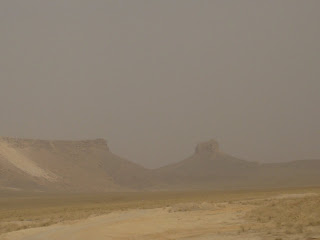At the end of the dry season, Central Iran is dusty. The mountains
seem to wear their own gauzy veil, only making themselves visible to
us close up. They are jagged, like rows of uneven monster teeth,
though the highest is only around 4000m (and formerly called Penis
Mountain in Farsi). When I asked the Nomads what sort of rock the
ranges are made of, they laughed, and said 'just rock'. The valleys
are flat and broad, with dry river beds snaking through some of them
in the dry.
The colour of the ground and the maintains is a faint beige, and the
sky is a constant pale blue. Like Australia, the vegetation, at least
at this time of year, is sparse and scrubby though small, ground-level
purple flowers can be found dotted around some of the sites we visit.
They are related to the saffron plant.
The dust irritates our throat and eyes, and we sneeze as we step into
it. The veil is at least useful as a filter when we're out walking,
but it must be unbearably hot to wear in Summer when temperatures in
Iran can reach 40-55 degrees celsius. Now, in autumn, it's a
comfortable temperature - perhaps mid to high twenties at the height
of the day, and chilly, but not freezing, at night. If we travelled
here in April it would be a very different landscape as the snow
thawed and re-filled the rivers.

No comments:
Post a Comment